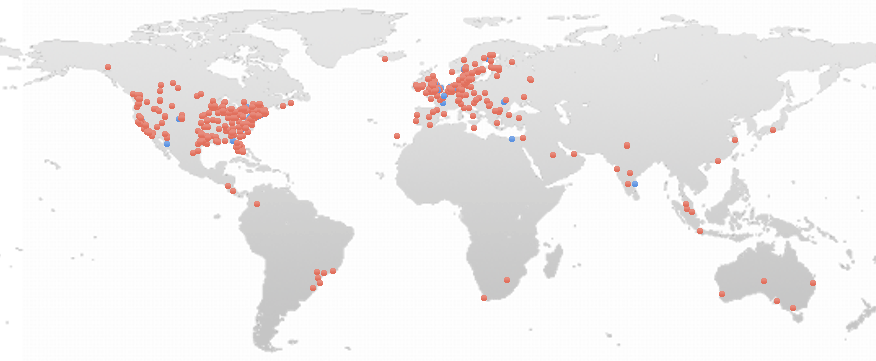So you want to write guest posts? Fabulous! Most welcome! This is a short guide that will help you format your articles to maximize your visual impact and readership on the site.
1. What you need to provide
In order to fit in the visual framework, you need to provide a bio of about 50 words that will go on the bottom of all your posts. Look at any article and you’ll get a feel for it. You’ll also need a gravatar connected to your email address for the same reason. Make sure it’s high-res enough to scale well; I would use an original of at least 200×200 pixels.
Oh, and your Twitter alias should be provided in the “AIM” field in your user profile for the footer and about-the-author box of your articles as well, so that people can follow you after having read your articles. Also, once you’re set up as a guest writer on this WordPress installation, if you have a Flattr account, you should register that so the flattr money for the article goes to you. You do that on the WordPress Dashboard under Flattr, here. Enter your Flattr ID and then authenticate.
2. What you’ll get in return
Guest writers are given a lot of visibility on FoI in return for contributing. In addition to being part of the normal newsflow, your articles will highlight on the front page for much longer than normal, and your name will be extensively shown in conjunction with the article. You should also expect people to follow you on Twitter from reading articles here.
Traffic is currently (February 29, 2012) at just over one million page views per month.
3. Article Image, Graphics
Every article has (at least) one image. It can be free or nonfree, that doesn’t really matter, but it will be cropped to 16×9 aspect ratio as you upload it. It is often preferable to crop oneself. Make sure it is at least 800px wide and preferably around 1000px — much larger than will be used in final production, and set it as the featured image on the article (far down right in the settings for the article). WordPress will size down the image for a number of different purposes, so your original should ideally be larger than the largest target (646px wide) by at least 50%. Do not include it at the top of the article — WordPress will take care of that.
Please consider accessibility for blind or visually impaired readers, and describe the image briefly in the ALT and TITLE texts. As an example, “Two people in business suits shaking hands, both crossing fingers behind their backs” would be a good description. Enough to convey the image’s symbolism, but not more.
If you need to credit a photographer, like with a CC-BY image, do so in the same ALT and TITLE texts.
If you don’t have access to stock photography, there is a great meta-search site for free-to-use stock photos. Just make sure to credit the photographer in the Title and Alt fields, like in this article (hover over the photo) in cases where it is required.
Consider that the top 25% of the photo is lost to the header text when picking a photo. Often, a tangentially related photo can be more effective for the article than one that’s spot on the topic: consider this article, about stupidity of the copyright industry, richly illustrated by a stupid-looking bird rather than portraying the exact scenario of the article (which is about a living room with people watching a movie).
Embedding videos in articles are done, for YouTube, by writing {youtube videocode 621 379} alone on a line, except with square brackets, where “videocode” is the YouTube URL part that looks like line noise.
4. The Lead Paragraph
The lead paragraph receives a larger, bolded text on-screen and in the RSS flow, and needs to summarize the article to make people want to read the entire piece. It has a specific three-sentence format: Fact. Background. Perspective. The initial “Fact” sentence writes the key point of the entire article.
Examples of the Fact-Background-Perspective format:
- Early Tuesday morning, the petition to the U.S. Administration to fire Carmen Ortiz reached the prerequisite 25,000 signatures. Carmen Ortiz was the prosecutor that drove the prosecution against Aaron Swartz, which many mean contributed or led to his tragic suicide. The U.S. Administration, by its own rules, must now take the petition seriously and respond to it.
- The European Parliament has passed a resolution that condemns the upcoming attempt from the International Telecommunications Union (ITU) to assert control over the Internet. This follows an attempt from the ITU to assert itself as the governing body and control the Internet. The resolution breeds hope that the Internet can stay out of the hands of the telecom oligopolies.
- Today, the European Parliament ordered new legislation to regulate credit card companies’ ability to refuse service. This regulation follows the unilateral and rightless cutoff of donations to WikiLeaks, as well as similar trampling on small entrepreneurs. The Pirate Party took the initiative to the new regulation.
- Due process of law failed on many accounts in the trial against the two operators of The Pirate Bay, its media spokesperson, and a fourth unrelated person. The trial was characterized by first deciding that the operations were criminal, then finding somebody to punish, and finally trying to determine a criminal act they could be held accountable to. In any civilized country where process of law works, the exact reverse order is followed.
You do not need to do anything to accomplish the formatting of the lead, it is done by the framework. Also, note that your name and the article category are inserted at the start of this paragraph, even though it doesn’t show on the web page.
5. The Article Title
The title choice makes or breaks an article. It needs to be provocative and tease the reader enough to at least read the lead paragraph. This is where most good articles fail, sadly. Examples of bad titles include:
Macropathy Vs. The Swarm(incomprehensible)I Thought Of Something(totally undescript)In Soviet Russia, Things Are Different(funny but says nothing about the topic)
I find it useful to make the title answer the question “Why am I writing this piece?” in an emotional manner. I think about what gave me energy to write this piece, and use that for a title. Examples of such titles: Because…
- With Latest Domain Seizures, The U.S. Declares Trade War On World
- We Should Be Spending Billions Fighting Bathtubs, Not Terrorism
- Trusting Telcos With Internet Is Like Trusting Fox With Henhouse
Finally, We Write Titles With Every Word Capitalized, Including Of, When, And If.
6. Subheadings
Sometimes, particularly in long articles, we need subheadings. Use H3. The page title is H1 and the article title is H2. The numbered subheadings on this style guide page are H3.
7. Info Box
If you need an info box, there is a class for that. Use the redbox div class with the header span class, like this:
<div class="redbox"><span class="header">INFO</span>
This is information related to the post, of whatever kind you think is relevant. </div>This will produce the following box:
This is information related to the post, of whatever kind you think is relevant.
Try to not use the information box for things that are part of the article flow – rather, use it for out-of-band, factual information that the reader should be aware of. It’s a very strong attention-grabber. Example of usage:
The author owns stock in the two corporations discussed in this article.
8. Article Categories
You should at least make sure to check the Headlines category and the Guest Writers category. They are administrative categories and will not show up in the post. Then pick one or two more, like a topic and a geography, that become the actual article category or categories.
9. Article Tags
The tags associated with the article are currently not used, and there are no plans to change that. Don’t bother with them.
10. Topics and Audience
Topics could be ranging from philosophical 10,000-feet analysis of how society is being reshaped by new technology to concrete, solid news reporting of what’s happening in a particular country. The only limit is that they should have a pirate, information policy-based perspective.
Our primary audience is the policymakers, advisors to policymakers, and similar influential people who need a nudge to get them to think. Our secondary audience is the leaders of pirate and civil liberties movements. We are not primarily aimed at the activist level, although understanding of that level is crucial to leading it.
Articles published here are read by people in the European Parliament and the European Commission. You reach the highest level of political offices in the world’s largest economy when writing here. Make good use of that.

11. Rights
Do note that all text material here is published under CC0, that is, no copyright at all. If you post here, the article is irrevocably out of copyright and in the public domain.
12. Publication
Sync your publication time for articles with Falkvinge and other writers (or just with Falkvinge, whose job it is to space articles evenly). However, do note that an article, once published, stays up. It is literally not possible to unpublish something, as it also goes out in feeds, mail, Twitter, etc. Removing it from the blog will just break links to what people have already read. For the same reason, never move a publication date for something that’s already been published — it breaks the link.


